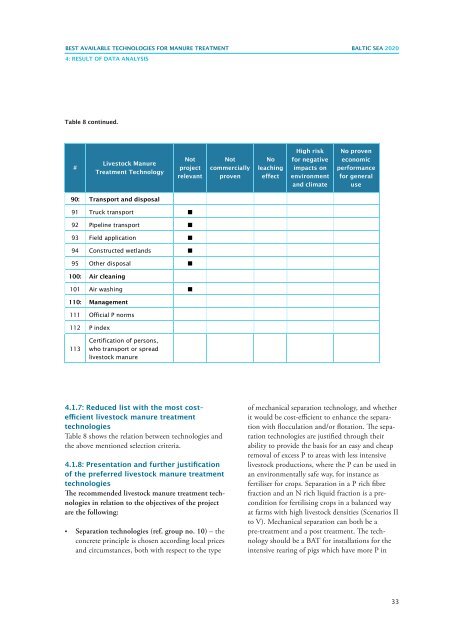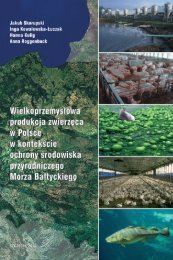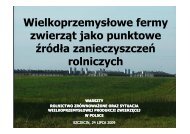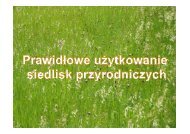best available technologies for manure treatment - Baltic Green Belt
best available technologies for manure treatment - Baltic Green Belt
best available technologies for manure treatment - Baltic Green Belt
You also want an ePaper? Increase the reach of your titles
YUMPU automatically turns print PDFs into web optimized ePapers that Google loves.
Best Available Technologies <strong>for</strong> <strong>manure</strong> <strong>treatment</strong> baltic sea 2020<br />
4: RESULT OF DATA ANALYSIS<br />
Table 8 continued.<br />
#<br />
Livestock Manure<br />
Treatment Technology<br />
Not<br />
project<br />
relevant<br />
Not<br />
commercially<br />
proven<br />
No<br />
leaching<br />
effect<br />
High risk<br />
<strong>for</strong> negative<br />
impacts on<br />
environment<br />
and climate<br />
No proven<br />
economic<br />
per<strong>for</strong>mance<br />
<strong>for</strong> general<br />
use<br />
90: Transport and disposal<br />
91 Truck transport <br />
92 Pipeline transport <br />
93 Field application <br />
94 Constructed wetlands <br />
95 Other disposal <br />
100: Air cleaning<br />
101 Air washing <br />
110: Management<br />
111 Official P norms<br />
112 P index<br />
113<br />
Certification of persons,<br />
who transport or spread<br />
livestock <strong>manure</strong><br />
4.1.7: Reduced list with the most cost–<br />
efficient livestock <strong>manure</strong> <strong>treatment</strong><br />
<strong>technologies</strong><br />
Table 8 shows the relation between <strong>technologies</strong> and<br />
the above mentioned selection criteria.<br />
4.1.8: Presentation and further justification<br />
of the preferred livestock <strong>manure</strong> <strong>treatment</strong><br />
<strong>technologies</strong><br />
The recommended livestock <strong>manure</strong> <strong>treatment</strong> <strong>technologies</strong><br />
in relation to the objectives of the project<br />
are the following:<br />
• Separation <strong>technologies</strong> (ref. group no. 10) – the<br />
concrete principle is chosen according local prices<br />
and circumstances, both with respect to the type<br />
of mechanical separation technology, and whether<br />
it would be cost-efficient to enhance the separation<br />
with flocculation and/or flotation. The separation<br />
<strong>technologies</strong> are justified through their<br />
ability to provide the basis <strong>for</strong> an easy and cheap<br />
removal of excess P to areas with less intensive<br />
livestock productions, where the P can be used in<br />
an environmentally safe way, <strong>for</strong> instance as<br />
fertiliser <strong>for</strong> crops. Separation in a P rich fibre<br />
fraction and an N rich liquid fraction is a precondition<br />
<strong>for</strong> fertilising crops in a balanced way<br />
at farms with high livestock densities (Scenarios II<br />
to V). Mechanical separation can both be a<br />
pre-<strong>treatment</strong> and a post <strong>treatment</strong>. The technology<br />
should be a BAT <strong>for</strong> installations <strong>for</strong> the<br />
intensive rearing of pigs which have more P in<br />
33








